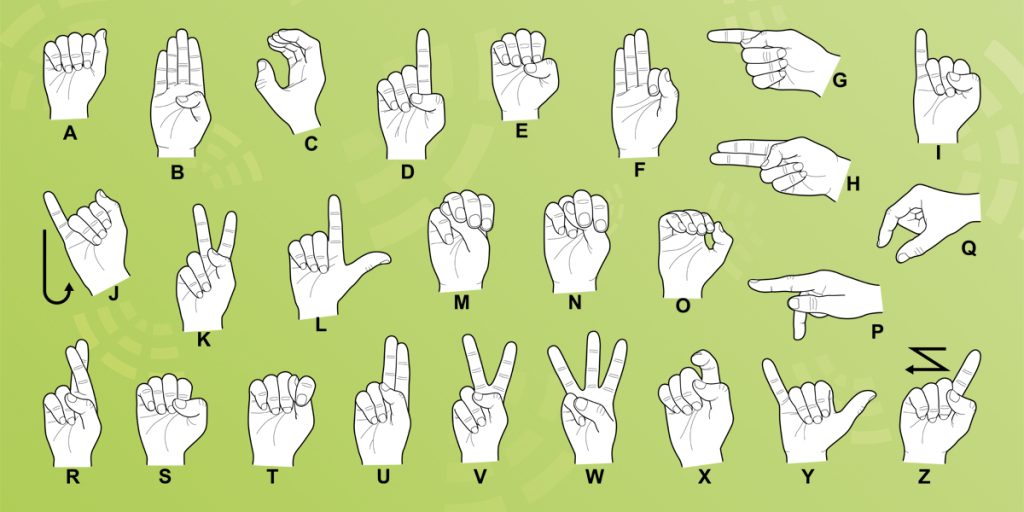Sign language is a fascinating and rich form of communication used by millions of people worldwide. It offers a visual alternative to spoken language, with its own grammar, vocabulary and culture. In this blog, you’ll learn all about sign language, from the different types to the use of the alphabet.
What is Sign Language?
Sign language is a natural language that uses hand gestures, facial expressions, body postures and mouth movements to communicate. It is not a universal language; each country or region has its own sign language. For example, there are about 140 different national sign languages worldwide, including Dutch Sign Language (NGT) and American Sign Language (ASL).
The Importance of Sign Language in the Netherlands
In the Netherlands, between 15,000 and 18,000 deaf people use sign language as their first language. For this community, NGT is invaluable. It is not only a means of communication, but also an important part of their identity and culture. Since 2020, NGT has been recognized as an official language in the Netherlands, an important step toward inclusion and equality.
Different Sign Languages
Just as spoken languages vary by country, so do sign languages. Here are some well-known sign languages:
- Dutch Sign Language (NGT): The official sign language in the Netherlands, used by the deaf community.
- American Sign Language (ASL): Used in the United States and parts of Canada.
- British Sign Language (BSL): Used in the United Kingdom and differs significantly from ASL and NGT.
- Langue des Signes Française (LSF): French sign language, one of the oldest in the world.
The fact that sign languages show so much variation worldwide shows how dynamic and culturally influenced these languages are.
The Alphabet in Sign Language
An important part of sign language is the hand alphabet, also called finger spelling. It allows you to spell individual letters to convey, for example, names or unfamiliar words. Each sign language has its own hand alphabet.
In NGT, the alphabet consists of one-handed gestures, while in BSL, two hands are often used. Learning the hand alphabet is a good way to become familiar with sign language and is often a first step for beginners.

A little practice
Can you “read” the below now? Let us know in the comments!

How Sign Language Differs from Spoken Language
Although sign language is similar to spoken language in terms of communication, there are major differences. Sign language, for example, has its own grammar that is often visually oriented. Sentence structures in NGT, for example, are based on the use of space and movement, while spoken language is linear.
In addition, nonverbal communication plays a greater role in sign language. Facial expressions, for example, can change the tone of a message or provide additional information.
Learning Sign Language
If you want to learn sign language, there are plenty of options in the Netherlands. From short courses to extensive training, you can choose a path that suits you, depending on your goals and time.
(Online) Courses
Several organizations and institutions offer courses and workshops for beginners and advanced students. Some examples are:
- The Dutch Sign Language course from the LOI
- The Dutch Sign Language course from the NHA
- Workshops of the Dutch Sign Language Center
- The online sign dictionary of the Dutch Sign Language Center
- The website Gesture of the Day, with a new gesture every day!
Apps
Several apps allow you to learn sign language at your own pace:
- HandTalk is a free digital dictionary for translations into American Sign Language. The app is available for iOS and Android.
- The Children’s Signs app contains over 200 gestures and is aimed specifically at teaching sign language to both deaf and hearing children. This app is also available for iOS and Android.
Training in Sign Language Interpreter
If you want to work professionally with sign language, you can choose to train as a sign language teacher and/or sign language interpreter, for example.
- Full-time course (4 years) Teacher of Dutch Sign Language (NGT)/Interpreter NGT at the Hogeschool Utrecht (HU).
- Bachelor program (3 years) Sign Language Linguistics at the University of Amsterdam (UvA).
Learning in Practice
In addition to formal education, it is important to practice the language in real-life situations. Consider:
- Volunteering in the deaf community: Allows you to improve your skills and contribute at the same time.
- Contact with deaf people: Communicating regularly with sign language learns the nuances and dynamics of language.
These opportunities offer everyone from interested beginners to aspiring professionals the chance to learn sign language and become part of a more inclusive society.
Technology and Sign Language
Technology is playing an increasing role in supporting sign language users. Think of apps that convert spoken language into gestures or vice versa, or videos with subtitles and sign language interpreters. These innovations make communication more accessible and contribute to a more inclusive society.
Sign Language and Culture
Sign language is more than just a means of communication; it is an integral part of the culture of deaf communities. Its use brings pride, belonging and identity. By learning or supporting sign language, you contribute to the preservation and recognition of this rich culture.
Summary
Sign language is a unique and valuable form of communication used by millions of people worldwide. With about 140 different sign languages, each with its own grammar and culture, it is a diverse and fascinating subject. In the Netherlands, NGT plays an important role in the community of deaf people. By learning and supporting sign language, you can contribute to a more inclusive society and enrich yourself with a new way to communicate.







